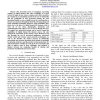Free Online Productivity Tools
i2Speak
i2Symbol
i2OCR
iTex2Img
iWeb2Print
iWeb2Shot
i2Type
iPdf2Split
iPdf2Merge
i2Bopomofo
i2Arabic
i2Style
i2Image
i2PDF
iLatex2Rtf
Sci2ools
CIIA
2009
2009
Sharing and Protecting Networked Digital Life Memories
The increasing power of computers, increasing capacity of digital memory and wider availability of a great variety of input devices such as cameras and video recorders, has resulted in an astonishing growth in the use of multimedia and the production of user generated content. It's now becoming feasible to store a digital record of everything that a person sees and hears throughout their life, all using cheap and easily obtainable commodity hardware. Such possibilities have given rise to the idea of a digital human life memory, able to store all of the video, photographs, documents and communications that relate to us as we travel through our lives. We explore how networked systems can be used to extend the capabilities of digital human life memory stores. Not only through the networking of the memory stores themselves, but also through the use of networked appliances, networked virtual worlds and wireless sensors network technologies. As well as the benefits, the massive increase...
| Added | 08 Nov 2010 |
| Updated | 08 Nov 2010 |
| Type | Conference |
| Year | 2009 |
| Where | CIIA |
| Authors | Madjid Merabti |
Comments (0)

